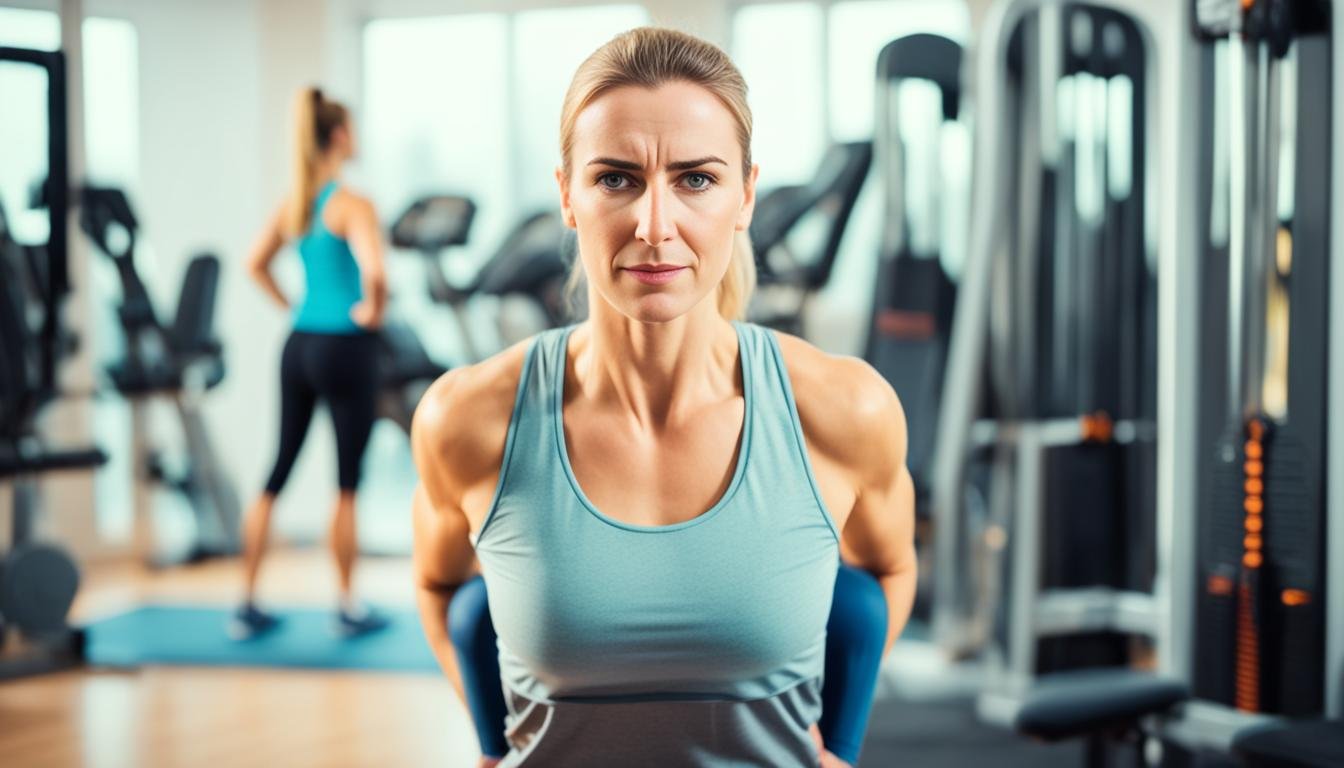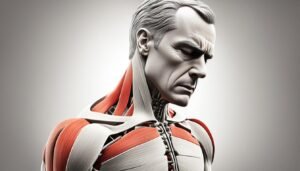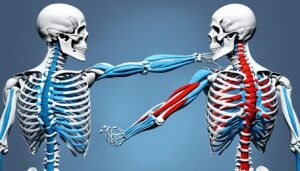It’s common to feel a little sore after a workout. But if lower back pain stays with you, it could be more serious. Often, we start exercising without knowing the basics, like posture and how much weight to use. This can work against our goal of getting healthy, and may lead to injuries. So, always pay attention to how your body feels and avoid pushing too hard.
Exercise is great for making us stronger, more flexible, and agile. Yet, overdoing it, or not being careful how we exercise, can actually hurt our fitness. The U.S. Department of Health says many people hurt their backs by suddenly lifting heavy weights. Also, not having the right posture while working out can make any back issues worse.
Key Takeaways
- Persistent lower back pain after a gym workout may indicate an underlying condition.
- Ignoring proper form, weight, and intensity during exercises can lead to injuries.
- Understanding your body’s needs and being mindful of potential issues is crucial before working out.
- Sudden high-intensity lifting and poor posture during exercise can cause back injuries.
- Engaging in healthy exercise habits is important to avoid harming your overall fitness.
Understanding Normal vs. Concerning Lower Back Pain Post-Workout
It’s common to feel tight or tense in your lower back after some exercise. Deadlifts and squats, for example, use your back muscles a lot. This can make them feel sore. A dull ache or soreness after working out is usually just a part of lower back pain after gym sessions. This is called delayed-onset muscle soreness (DOMS).
DOMS happens because our body tries to fix the tiny muscle tears workouts cause. So, you might notice pain in your lower back slowly getting worse after a workout. It might start 6 to 8 hours later, get worse over 24 to 48 hours, and then gets better in about 72 hours.
When Lower Back Pain After a Workout is Normal
Remember, not all lower back pain after gym is the same. If you feel a sharp pain right after working out or have pain that stays in one spot, it’s not good. This early or sharp pain might be a lower back muscle strain. This kind of pain can last 72 to 96 hours after your workout.
A hurt back can bring other problems too. You might feel tender, have pain that runs to other parts, feel weak, or notice swelling. These are signs something might be wrong.
When Lower Back Pain After Workout Becomes a Concern
Persistent back pain for 72 to 96 hours could be a sign of a serious injury. It’s very important to see a doctor in these cases. They need to find out what’s really going on. It’s especially true if you have existing health problems like arthritis or herniated discs. Changing your exercises can help prevent future lower back pain.
Causes of Lower Back Pain Post-Workout
Exercising in the wrong way can hurt your lower back. This can happen by not moving right, lifting too much, or having old injuries. Doing the same movements over and over can wear out muscles and joints. This can cause swelling, weakness, and a lot of pain. It’s smart to mix up your workout to target different areas.
Overuse Injuries
Lifting weights or working out the wrong way can hurt your muscles and ligaments. It can also put too much stress on your spine and joints. This might cause problems like a bad alignment, or even breaks, and dislocations. It’s important to do exercises the right way.
Poor Posture
Your core muscles are very important for keeping your back strong. They are not just the abs in the front. They also include the muscles on the sides, the back muscles, and a muscle deep inside your belly called the transverse abdominal. If you don’t work these muscles, your back could start hurting more and more over time.
Weak Core Muscles
Not drinking enough water before, during, or after you exercise can make your back hurt a lot. Water keeps the cushions between your spine bones healthy. But without enough water, these cushions get less fluid and this causes pain and inflammation.
Dehydration
If you have health problems like arthritis, or if you’ve hurt your back before, working out wrong can make it feel worse. To prevent this, you should exercise in a way that doesn’t harm these conditions further. It’s important to adjust your workout to stay safe.
Pre-Existing Conditions
If you have health problems like arthritis, or if you’ve hurt your back before, working out wrong can make it feel worse. To prevent this, you should exercise in a way that doesn’t harm these conditions further. It’s important to adjust your workout to stay safe.
Treatment Options for Lower Back Pain After a Workout
Feel lower back pain after working out? You’re not alone. Luckily, there are many ways to get relief. Using home treatments and professional help are smart choices to help you feel better.
Rest and Ice
Resting is key to prevent more back pain. Put ice on your back for at least 20 minutes. This reduces swelling, tightness, and pain. Always cover the ice with a cloth to protect your skin.
Pain Medications
Doctors may advise you to take over-the-counter drugs like NSAIDs or muscle relaxants. These can help lower pain and swelling. Remember, they work best when paired with other treatments.
Physical Therapy
Physiotherapists suggest special exercises to ease lower back pain. They help make your back stronger and more flexible. They also teach you ways to prevent injuries in the future.
Chiropractic Adjustments
At Physiotattva, a chiropractor can adjust your spine by hand. This can fix any bone misalignment that might be causing pain. It’s a hands-on way to treat your back pain.
Massage Therapy
Getting a massage can relax and loosen your back muscles. There are many massage types to choose from. They can make your back feel better and help you move easier as you heal.
Prevention Techniques for Lower Back Pain Post-Workout
Experts suggest key ways to avoid lower back pain after working out. Using the right form in exercises is crucial. Remember to keep your back, chin, neck, shoulders, and knees in a good position.
Gradual Progression
Start with small, easy exercises and work your way up. Doing this helps avoid putting too much strain on your lower back. It also lets your back get stronger without sudden stress.
Proper Warm-Up and Cool-Down
It’s important to warm up and cool down before and after you exercise. These steps lower soreness, swelling, and lactic acid. They also help your heart and blood flow work better.
Core Strengthening Exercises
Focus on core exercises like walking, exercise ball, or water workouts. These activities boost blood flow and make your muscles stretch and grow strong.
Stretching
Try stretching, especially your hamstrings, to ease pressure and stop back pain. Stretching also makes you more flexible, relaxes your muscles, and makes your spine longer.
Avoiding High-Risk Exercises
Stay away from exercises that are tough on the spine. Bad moves or doing too much too soon can harm your back. This can lead to swelling, muscle spasms, and pain.
Adequate Rest and Recovery
Rest is important for your back, but it doesn’t mean you can’t exercise. Try easy, low-impact activities and breathing exercises. They help you heal and ease pain.
lower back pain after gym
Do you get a sore lower back after the gym? You’re not alone. Many athletes and everyday exercisers face this issue. It helps to know why it happens and how to prevent it.
Overexertion is a major cause. The U.S. Department of Health says doing too much too soon can hurt your back. This kind of mistake can cause muscle strain, ligament sprain, or nerve irritation</. Other things like old injuries, weak core muscles, and poor posture can also play a part.
It’s good to know what’s normal soreness and what’s worrying pain. If your lower back feels achy or tight a day or two after, it’s usually okay. But, if the pain is sharp and sticks around after you’ve stopped working out, you might have hurt yourself more seriously.
To avoid lower back pain after gym, work on your exercise form, slowly increase your workout, warm up and cool down properly, strengthen your core, and rest enough. These steps can lower the chances of getting hurt.
Still hurt? Go see a specialist like a physiotherapist or chiropractor. They can give you the right treatment and advice to get better and keep the pain away.
Protecting Your Lower Back During Sports and Physical Activity
People playing sports face a lot of body strain. Whether you’re into competitive sports or working out regularly, you should think about how to keep your back safe. Many times, lower back pain hits those who play for fun. Overusing muscles and doing the same movements a lot can lead to this pain.
One big reason for lower back pain is pushing too hard without break. This happens when athletes do more reps or add extra weight to their exercises. But doing this when tired can mess up your posture, hurting your back even more. Listening to your body is key here. Dr. Wyss says we should stop when our body signals us to slow down.
Listening to Your Body
Getting ready for sports or exercise should be done smartly. Even before a run, walk at a brisk pace to warm up. According to Dr. Wyss, a dynamic warm-up is really helpful. It involves moving warm-up exercises like lunges or a fast walk.
Dynamic Warm-Up
To keep your lower back safe, listen to what your body needs and slowly build up your fitness level. And doing dynamic warm-ups cuts down the chances of lower back pain, post-workout back pain, and other fitness injuries.
Identifying Severe Lower Back Pain After Workouts
Feeling some lower back discomfort is common. You don’t always need to rush to the doctor. Instead, change up your exercises. Do a good warm-up and cool down. Add ice afterward, Dr. Wyss suggests. But, if the lower back pain is really bad or affects how you move, see a doctor.
Coming back to sports after a back pain issue needs caution. Slowly pick up your activities. If the pain doesn’t get worse, you’re good to increase your effort next time. It’s a time to be careful and not overdo it, advises Dr. Wyss, to avoid more fitness injury prevention.
Common Causes of Lower Back Pain for Gym Enthusiasts
Many people get lower back pain after working out too hard. This might also happen if you lift too much weight or do exercises wrong. Always start new moves slowly and only add more when your body is ready. Pushing yourself too much can hurt your lower back.
Overexertion
Lifting really heavy weights or doing moves wrong can make your back sore. Be careful with actions like squats, deadlifts, and HIIT workouts. If you overdo it, your muscles get tired, which can lead to pain and injury.
Overworked Muscles
Venous insufficiency can also make your back hurt after a workout. This is when your veins can’t move your blood back to your heart well. It can cause blood to pool in your legs, which might lead to lower back pain.
Venous Insufficiency
Sometimes, a nerve in your lower back gets pinched during exercise. This can cause pain. If you feel this pain, take a break from working out. Give the nerve time to heal. Bad exercise moves or poor postures can cause a pinched nerve.
Pinched Nerve
Lifting heavy or doing moves wrong can hurt your back. Make sure your form is good, and you take enough rest. This can stop lower back pain after exercising.
Conclusion
At Physiotattva, we have a team ready to help you with your lower back pain relief. We have different treatments just for you. These include physiotherapy and aqua therapy. Our treatments help you understand and stop post-workout back pain.
Don’t stop reaching your fitness dreams because of pain. Start your recovery from back pain with us. We’re here to make you feel great again. Get back to the activities you enjoy, free from lower back pain.
We use the best techniques to keep you safe from fitness injury. These include using the right form and smart exercises. Let us lead you to a life without pain.




